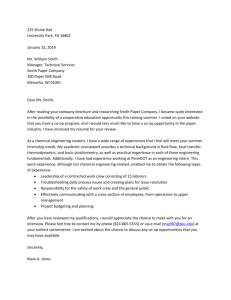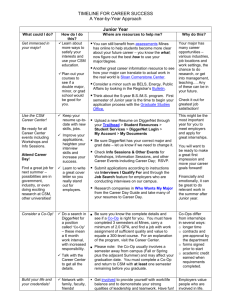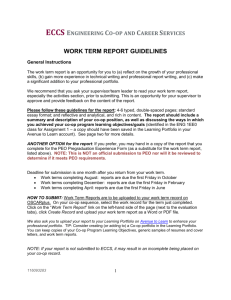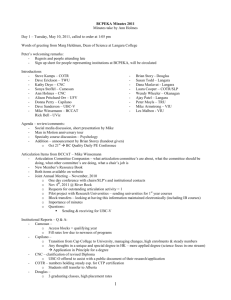Career Development Work Term Report
advertisement
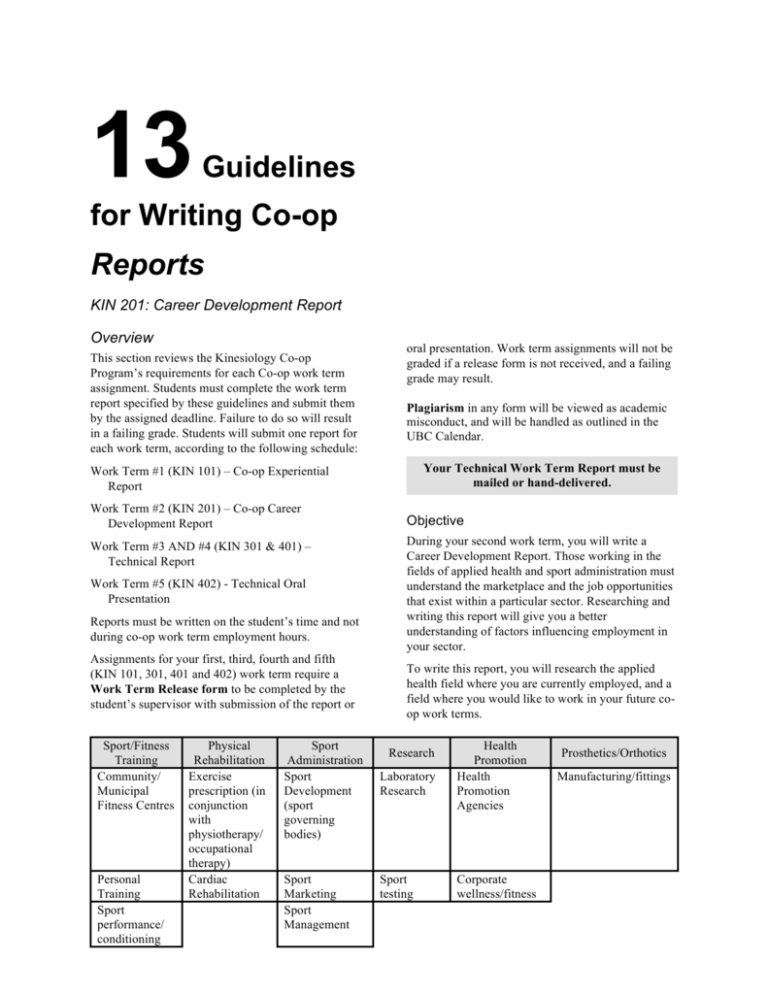
13 Guidelines for Writing Co-op Reports KIN 201: Career Development Report Overview This section reviews the Kinesiology Co-op Program’s requirements for each Co-op work term assignment. Students must complete the work term report specified by these guidelines and submit them by the assigned deadline. Failure to do so will result in a failing grade. Students will submit one report for each work term, according to the following schedule: oral presentation. Work term assignments will not be graded if a release form is not received, and a failing grade may result. Plagiarism in any form will be viewed as academic misconduct, and will be handled as outlined in the UBC Calendar. Your Technical Work Term Report must be mailed or hand-delivered. Work Term #1 (KIN 101) – Co-op Experiential Report Work Term #2 (KIN 201) – Co-op Career Development Report Work Term #3 AND #4 (KIN 301 & 401) – Technical Report Work Term #5 (KIN 402) - Technical Oral Presentation Reports must be written on the student’s time and not during co-op work term employment hours. Assignments for your first, third, fourth and fifth (KIN 101, 301, 401 and 402) work term require a Work Term Release form to be completed by the student’s supervisor with submission of the report or Sport/Fitness Training Community/ Municipal Fitness Centres Personal Training Sport performance/ conditioning Physical Rehabilitation Exercise prescription (in conjunction with physiotherapy/ occupational therapy) Cardiac Rehabilitation Sport Administration Sport Development (sport governing bodies) Sport Marketing Sport Management Objective During your second work term, you will write a Career Development Report. Those working in the fields of applied health and sport administration must understand the marketplace and the job opportunities that exist within a particular sector. Researching and writing this report will give you a better understanding of factors influencing employment in your sector. To write this report, you will research the applied health field where you are currently employed, and a field where you would like to work in your future coop work terms. Research Laboratory Research Sport testing Health Promotion Health Promotion Agencies Corporate wellness/fitness Prosthetics/Orthotics Manufacturing/fittings How to Begin Your Report • Define a term and introduce acronyms the first time they are used. You can also include a glossary of terms in the appendices; Identify, from the table above, the sectors of applied health and sport administration that you are currently working in as well as the sector that you would like to work in for future co-op work terms. This is a list of the primary sectors (with some overlap) in applied health and sport administration, however sectors not listed, can still be chosen for this report. • Use section headers and sub-header where appropriate. Start major sections of the report on new pages; • Use standard, formal English (Canadian spelling). Do not use slang, contractions and colloquialism; • Number the pages. All prefatory parts (pages which come before the body of the report) are numbered using lower case Roman numerals (ii, iii, iv, etc). The title page is not numbered, but is counted as the first page; numbering begins at ii on the Table on Contents. The body of the report must be numbered in Arabic numerals (1, 2, 3, etc). The first page of text is “1” and begins with the introduction; and • Double space and use 12 point font with 1” margins; • Bind the report in a suitable protective cover (duotang, cerlox or coil binding) Format The body of the Career Development Report should be 2,000 – 3,000 words. Other guidelines to follow when preparing the report: Assignment The following table outlines the requirements for this report: Section Purpose Content Title of the report Your name and student number Co-op course number (i.e. Work Term Two – KIN 201) Co-op employer Date report submitted Identifies contents and organization of document Section headings Page numbers List of Figures (if applicable) Identifies any figures, drawings, or photographs shown in the report Number of figures Title of figures and corresponding page numbers List of Tables (if applicable) Identifies any tables shown in the report Number of tables Title of tables and corresponding page numbers Introduction Introduces the sector that you are currently working within and any future sector(s) that you wish to work within Subject and purpose of the report: briefly state why the report is being written and what the report is intended to achieve Scope - describe how broad or how limited the treatment of the subject will be Title Page Table of Contents Identifies the topic and owner of the report Section Purpose Content Sector history Projected economic status of the sector Geographic locations of sector concentration (if applicable) Opportunities for Kinesiology students/graduates Major employers in the sector – list 5-8 and for each employer provide the following (in bullet, paragraph or table format): • Full name of company/agency and parent company/agency if applicable Section 1 Section 2 Section 3 Reviews your current work term sector in detail Provides an overview of your technical and nontechnical skills gained and developed in your current work term Identifies and assesses your desired future sector as it relates to your senior co-op work terms • Division, if applicable • Location (city, province/state, country) • Website address • Brief description of company or agency • Why you included the company/agency in your list (e.g. largest, most innovative, projected growth, international interest, etc.) Union involvement (if applicable) Economic factors influencing the sector Political factors influencing the sector Government involvement/control (if applicable) Advancement opportunities: hiring trends and long term prospects Environmental issues/factors (if applicable) Describe the technical skills required to succeed in this position Describe the non-technical skills required to succeed in this position Sector history Projected economic status of the sector Geographic locations of sector concentration (if applicable) Opportunities for Kinesiology students/graduates Major employers in the industry – list 5-8 and for each employer provide the following (in bullet, paragraph or table format) • Full name of company/agency and parent company/agency if applicable Section Section 4 Conclusion References/ Bibliography Purpose Content • Division, if applicable • Location (city, province/state, country) • Website address • Brief description of company or agency • Why you included the company/agency in your list (e.g. largest, most innovative, projected growth, international interest, etc.) Union involvement (if applicable) Economic factors influencing the industry Political factors influencing the industry Government involvement/control (if applicable) Advancement opportunities: hiring trends and long term prospects Environmental issues Review SYMPLICITY job postings or other resources that are in the identified sector and determine from the job descriptions which advanced skills you will need to gain in order to make yourself marketable for these postings. Describe the technical and non-technical skills required to succeed in this position Describe a detailed plan of action as to how you will attain these skills Provides final comments on your strategy to obtain your ‘dream’ coop position. List possible strategies that you will implement to assist you in becoming a highly sought after Kinesiology Coop student. Acknowledge use of materials from printed sources, websites and interviews with colleagues in the preparation of your report. Indicate exact source of all quotations and/or results of previous work. Author’s name, title of book, year published, publisher’s name, city, ISBN number, page number Bibliographic entries are listed alphabetically by the name of the author or by the first major work of the title. All sources must be cited correctly; please refer to the following UBC website for proper citation of all sources: http://toby.library.ubc.ca/subjects/subjpage2.cfm?id=673 Use APA, American Psychological Association, style for all citations. Provides an overview of the technical and nontechnical skills you will need to gain in order to attain your ideal senior co-op work term in the sector identified in Section 3 Note: This report is to be NON-CONFIDENTIAL; be sure that you do not include any proprietary company information pertaining to your position. Submission This report must be submitted to the Kinesiology Coop Office by 4pm on Friday of the eighth week of your work term. A hard copy of your bound report must be submitted; e-mailed submissions will not be accepted. Note: Only students on international placements may submit their report via e-mail. Grading The Co-op Coordinator will evaluate the Career Development Report. You will receive an overall evaluation on a scale ranging from “Excellent” to “Unsatisfactory.” Successful completion of your Coop work term is assessed on the quality of your work term report and a satisfactory Co-op Employer Evaluation from your employer. A pass (P) will be entered on your transcript for the completed Co-op work term. If you fail to obtain a “Satisfactory” mark on both your report and your Co-op Employer Evaluation, a fail (F) will be entered on your transcript. If only your report is marked “Unsatisfactory,” you will be given 30 days to make revisions and resubmit your report to the Co-op Coordinator for re-evaluation. The Career Development Report is graded out of 100 points and will be assessed as follows: Expression – 20 points Grammar & Spelling: 5 points each Clarity & Style: 5 points each Structure – 20 points Layout and Readability of the report: 10 points each Including proper table of contents, heading, and referencing Content – 60 points Section 1: Understanding of Current Sector: 20 points Section 2: Understanding of Technical Skills Required: 10 points Section 3: Understanding of Future WT Sector: 20 points Section 4: Understanding of Technical Skills Required: 10 points Excellent – 80 to 100 points Good – 65 to 79 points Satisfactory – 50 to 64 points Unsatisfactory – 0 to 49 points


